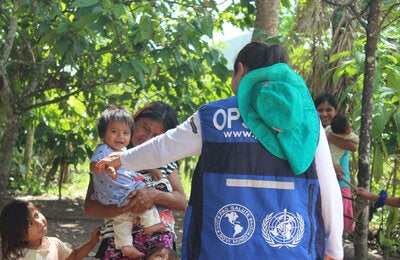
In the Americas, the number of people with diabetes has almost quadrupled since 1990.
Geneva/Washington D.C., 14 November 2024 (PAHO/WHO) - The number of adults living with diabetes worldwide has surpassed 800 million, more than quadrupling since 1990, according to new data released in The Lancet on World Diabetes Day. The analysis, conducted by the NCD Risk Factor Collaboration (NCD-RisC) with support from the World Health Organization (WHO), highlights the scale of the diabetes epidemic and an urgent need for stronger global action to address both rising disease rates and widening treatment gaps, particularly in low- and middle-income countries (LMICs).
“We have seen an alarming rise in diabetes over the past three decades, which reflects the increase in obesity, compounded by the impacts of the marketing of unhealthy food, a lack of physical activity and economic hardship," said WHO Director-General Dr Tedros Adhanom Ghebreyesus. “To bring the global diabetes epidemic under control, countries must urgently take action. This starts with enacting policies that support healthy diets and physical activity, and, most importantly, health systems that provide prevention, early detection and treatment.”
The study reports that global diabetes prevalence in adults rose from 7% to 14% between 1990 and 2022. LMICs experienced the largest increases, where diabetes rates have soared while treatment access remains persistently low. This trend has led to stark global inequalities: in 2022, almost 450 million adults aged 30 and older – about 59% of all adults with diabetes – remained untreated, marking a 3.5-fold increase in untreated people since 1990. Ninety per cent of these untreated adults are living in LMICs.
The study further reveals substantial global differences in diabetes rates, with the prevalence of diabetes among adults aged 18 and older around 20% in the WHO South-East Asia and the Eastern Mediterranean Regions. These two regions, together with the African Region, have the lowest rates of diabetes treatment coverage, with fewer than 4 in 10 adults with diabetes taking glucose-lowering medication for their diabetes.
Diabetes in the Americas Region
The study shows that in the Americas, 112 million adults (13% of the adult population) are living with diabetes; this is almost four times the number of adults with diabetes in 1990 (30 million adults, 7% of the adult population). In the Caribbean, the prevalence is even higher, reaching 20% of the adult population.
Ensuring access to treatment continues to be a challenge in the Region, with an estimated 43 million people with diabetes (aged 30 years or older) unable to access treatment, highlighting the urgent need to expand access to primary health care services.
The Pan American Health Organization (PAHO) initiative, Better Care for NCDs: Accelerating Actions in Primary Health Care, is an evidence-based initiative that provides Member States with the normative guidance needed to strengthen their primary care services to improve access and quality of care for non-communicable diseases, including diabetes.
PAHO also supports countries in the implementation of the type 2 diabetes clinical pathway, a standardized technical resource aimed at improving the quality and efficiency of health care for people with type 2 diabetes at primary health care level.
PAHO’s Regional Revolving Funds, a pooled procurement mechanism that enable countries of the Americas to access quality vaccines, essential medicines, and public health supplies at affordable prices, also offers high-quality diabetes medicines, including insulin, metformin and glicazide, as well as glucometers and related supplies.
WHO’s commitment to global diabetes response
Addressing the soaring diabetes burden, WHO is also launching a new global monitoring framework on diabetes today. This product represents a crucial step in the global response, providing comprehensive guidance to countries in measuring and evaluating diabetes prevention, care, outcomes and impacts. By tracking key indicators such as glycaemic control, hypertension and access to essential medicines, countries can improve targeted interventions and policy initiatives. This standardized approach empowers countries to prioritize resources effectively, driving significant improvements in diabetes prevention and care.
WHO’s Global Diabetes Compact, launched in 2021, includes the vision of reducing the risk of diabetes, and ensuring that all people who are diagnosed with diabetes have access to equitable, comprehensive, affordable and quality treatment and care. The work undertaken as part of the Compact will also support the prevention of type 2 diabetes from obesity, unhealthy diet and physical inactivity. In addition, the same year, a diabetes resolution was endorsed at the World Health Assembly urging Member States to raise the priority given to the prevention, diagnosis and control of diabetes as well as prevention and management of risk factors such as obesity.
In 2022, WHO established five global diabetes coverage targets to be achieved by 2030. One of these targets is to ensure that 80% of people with diagnosed diabetes achieve good glycemic control. Today’s release underlines the scale and urgency of action needed to advance efforts to close the gap.
The upcoming year 2025 presents a significant opportunity to catalyse action against the alarming rise in diabetes worldwide with the Fourth High-level Meeting of the United Nations General Assembly on the prevention and control of noncommunicable diseases (NCDs) to take place in September. This meeting brings heads of states and governments together to set a powerful vision for preventing and controlling NCDs, including diabetes, through a collective commitment to address root causes and improve access to detection and treatment. By aligning efforts towards the 2030 and 2050 goals, this high-level meeting is a pivotal moment for strengthening global health systems, including primary health care and halting the rise in the diabetes epidemic.
Notes for editors
The study released today was conducted by the NCD Risk Factor Collaboration (NCD-RisC), a worldwide network of over 1500 researchers and practitioners, in collaboration with WHO. It is the first global analysis of trends in both diabetes rates and treatment coverage that is based on data from over 140 million people aged 18 years or older that were included in more than 1000 studies covering populations in all countries. The study used an updated methodology of measuring diabetes prevalence in populations from previous studies to provide a more accurate overview of the global diabetes epidemic.



